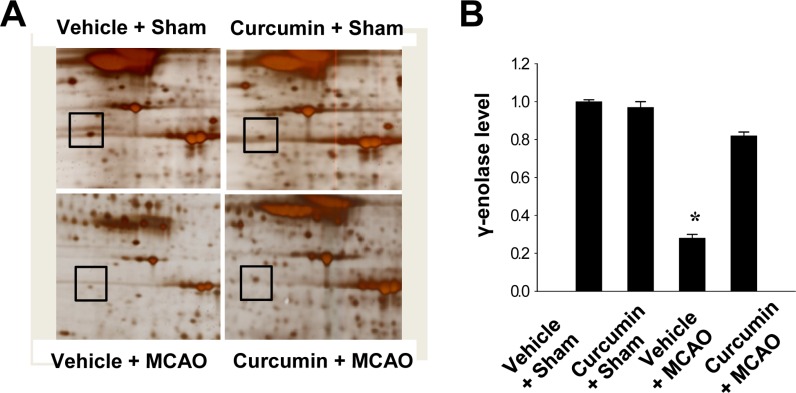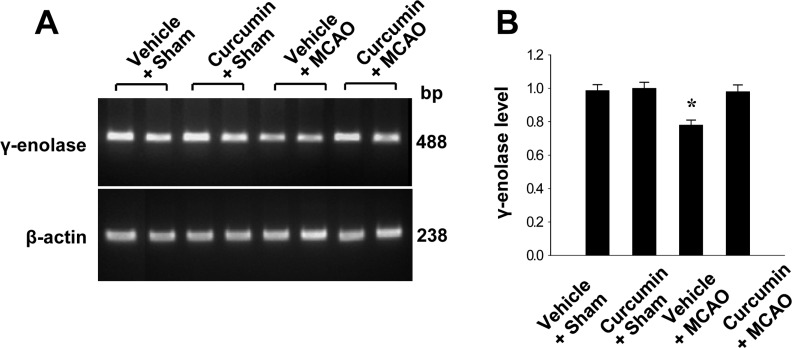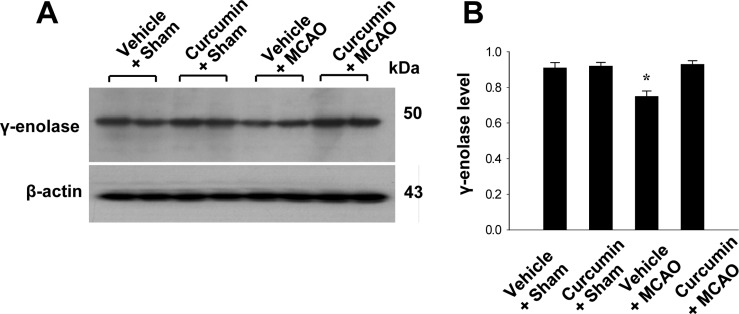Lab Anim Res.
2015 Dec;31(4):198-203. 10.5625/lar.2015.31.4.198.
Curcumin attenuates the middle cerebral artery occlusion-induced reduction in gamma-enolase expression in an animal model
- Affiliations
-
- 1Department of Anatomy, College of Veterinary Medicine, Institute of Agriculture and Life Science, Gyeongsang National University, Jinju, Korea. pokoh@gnu.ac.kr
- KMID: 2312146
- DOI: http://doi.org/10.5625/lar.2015.31.4.198
Abstract
- Curcumin exerts a protective effect in cerebral ischemia through its anti-oxidant and anti-inflammatory activities. gamma-enolase is a glycolytic enzyme expressed in neurons that is known to exerts a neuroprotective effect. We investigated whether curcumin regulates gamma-enolase expression in focal cerebral ischemic injury in rats. Middle cerebral artery occlusion (MCAO) was performed to induce focal cerebral ischemia. Adult male rats were injected intraperitoneally with either vehicle or curcumin (50 mg/kg) 1 h after MCAO and cerebral cortex tissues were isolated 24 h after MCAO. We found that MCAO-induced injury resulted in a reduction in gamma-enolase expression in vehicle-treated animals using a proteomics approach. However, this reduction was attenuated in animals with MCAO treated with curcumin. Reverse-transcription PCR and Western blot analyses also showed that curcumin treatment prevented the MCAO injury-induced reduction in gamma-enolase expression. The results of this study suggest that curcumin exerts its neuroprotective function in focal cerebral ischemia by regulating the expression of gamma-enolase.
Keyword
MeSH Terms
Figure
Cited by 1 articles
-
Hyperglycemia decreases preoxiredoxin-2 expression in a middle cerebral artery occlusion model
Phil-Ok Koh
Lab Anim Res. 2017;33(2):98-104. doi: 10.5625/lar.2017.33.2.98.
Reference
-
1. Schmechel DE, Brightman MW, Marangos PJ. Neurons switch from non-neuronal enolase to neuron-specific enolase during differentiation. Brain Res. 1980; 190(1):195–214. PMID: 6769533.
Article2. Rider CC, Taylor CB. Enolase isoenzymes in rat tissues. Electrophoretic, chromatographic, immunological and kinetic properties. Biochim Biophys Acta. 1974; 365(1):285–300. PMID: 4413246.
Article3. Hattori T, Ohsawa K, Mizuno Y, Kato K, Kohsaka S. Synthetic peptide corresponding to 30 amino acids of the C-terminal of neuron-specific enolase promotes survival of neocortical neurons in culture. Biochem Biophys Res Commun. 1994; 202(1):25–30. PMID: 8037719.
Article4. Hattori T, Takei N, Mizuno Y, Kato K, Kohsaka S. Neurotrophic and neuroprotective effects of neuron-specific enolase on cultured neurons from embryonic rat brain. Neurosci Res. 1995; 21(3):191–198. PMID: 7753500.
Article5. Ammon HP, Wahl MA. Pharmacology of Curcuma longa. Planta Med. 1991; 57(1):1–7. PMID: 2062949.6. Wu A, Ying Z, Gomez-Pinilla F. Dietary curcumin counteracts the outcome of traumatic brain injury on oxidative stress, synaptic plasticity, and cognition. Exp Neurol. 2006; 197(2):309–317. PMID: 16364299.
Article7. Guo L, Xing Y, Pan R, Jiang M, Gong Z, Lin L, Wang J, Xiong G, Dong J. Curcumin protects microglia and primary rat cortical neurons against HIV-1 gp120-mediated inflammation and apoptosis. PLoS One. 2013; 8(8):e70565. PMID: 23936448.
Article8. Wang Q, Sun AY, Simonyi A, Jensen MD, Shelat PB, Rottinghaus GE, MacDonald RS, Miller DK, Lubahn DE, Weisman GA, Sun GY. Neuroprotective mechanisms of curcumin against cerebral ischemia-induced neuronal apoptosis and behavioral deficits. J Neurosci Res. 2005; 82(1):138–148. PMID: 16075466.
Article9. Yang F, Lim GP, Begum AN, Ubeda OJ, Simmons MR, Ambegaokar SS, Chen PP, Kayed R, Glabe CG, Frautschy SA, Cole GM. Curcumin inhibits formation of amyloid beta oligomers and fibrils, binds plaques, and reduces amyloid in vivo. J Biol Chem. 2005; 280(7):5892–5901. PMID: 15590663.10. Thiyagarajan M, Sharma SS. Neuroprotective effect of curcumin in middle cerebral artery occlusion induced focal cerebral ischemia in rats. Life Sci. 2004; 74(8):969–985. PMID: 14672754.
Article11. Zhao J, Zhao Y, Zheng W, Lu Y, Feng G, Yu S. Neuroprotective effect of curcumin on transient focal cerebral ischemia in rats. Brain Res. 2008; 1229:224–232. PMID: 18640105.
Article12. Zhao J, Yu S, Zheng W, Feng G, Luo G, Wang L, Zhao Y. Curcumin improves outcomes and attenuates focal cerebral ischemic injury via antiapoptotic mechanisms in rats. Neurochem Res. 2010; 35(3):374–379. PMID: 19774461.
Article13. Longa EZ, Weinstein PR, Carlson S, Cummins R. Reversible middle cerebral artery occlusion without craniectomy in rats. Stroke. 1989; 20(1):84–91. PMID: 2643202.
Article14. Gim SA, Koh PO. Ferulic acid prevents the injury-induced decrease of γ-enolase expression in brain tissue and HT22 cells. Lab Anim Res. 2014; 30(1):8–13. PMID: 24707299.
Article15. Ghoneim AI, Abdel-Naim AB, Khalifa AE, El-Denshary ES. Protective effects of curcumin against ischaemia/reperfusion insult in rat forebrain. Pharmacol Res. 2002; 46(3):273–279. PMID: 12220971.
Article16. Liu ZJ, Liu W, Liu L, Xiao C, Wang Y, Jiao JS. Curcumin Protects Neuron against Cerebral Ischemia-Induced Inflammation through Improving PPAR-Gamma Function. Evid Based Complement Alternat Med. 2013; 2013:470975. PMID: 23762140.
Article17. Takei N, Kondo J, Nagaike K, Ohsawa K, Kato K, Kohsaka S. Neuronal survival factor from bovine brain is identical to neuron-specific enolase. J Neurochem. 1991; 57(4):1178–1184. PMID: 1895102.
Article18. Hafner A, Obermajer N, Kos J. γ-Enolase C-terminal peptide promotes cell survival and neurite outgrowth by activation of the PI3K/Akt and MAPK/ERK signalling pathways. Biochem J. 2012; 443(2):439–450. PMID: 22257123.
Article19. Wu J, Li Q, Wang X, Yu S, Li L, Wu X, Chen Y, Zhao J, Zhao Y. Neuroprotection by curcumin in ischemic brain injury involves the Akt/Nrf2 pathway. PLoS One. 2013; 8(3):e59843. PMID: 23555802.
Article
- Full Text Links
- Actions
-
Cited
- CITED
-
- Close
- Share
- Similar articles
-
- Ferulic acid prevents the injury-induced decrease of gamma-enolase expression in brain tissue and HT22 cells
- Quercetin attenuates the injury-induced reduction of γ-enolase expression in a middle cerebral artery occlusion animal model
- Curcumin treatment recovery the decrease of protein phosphatase 2A subunit B induced by focal cerebral ischemia in Sprague-Dawley rats
- Alleviation of γ-enolase decrease by the chlorogenic acid administration in the stroke animal model
- Quercetin attenuates the reduction of parvalbumin in middle cerebral artery occlusion animal model




